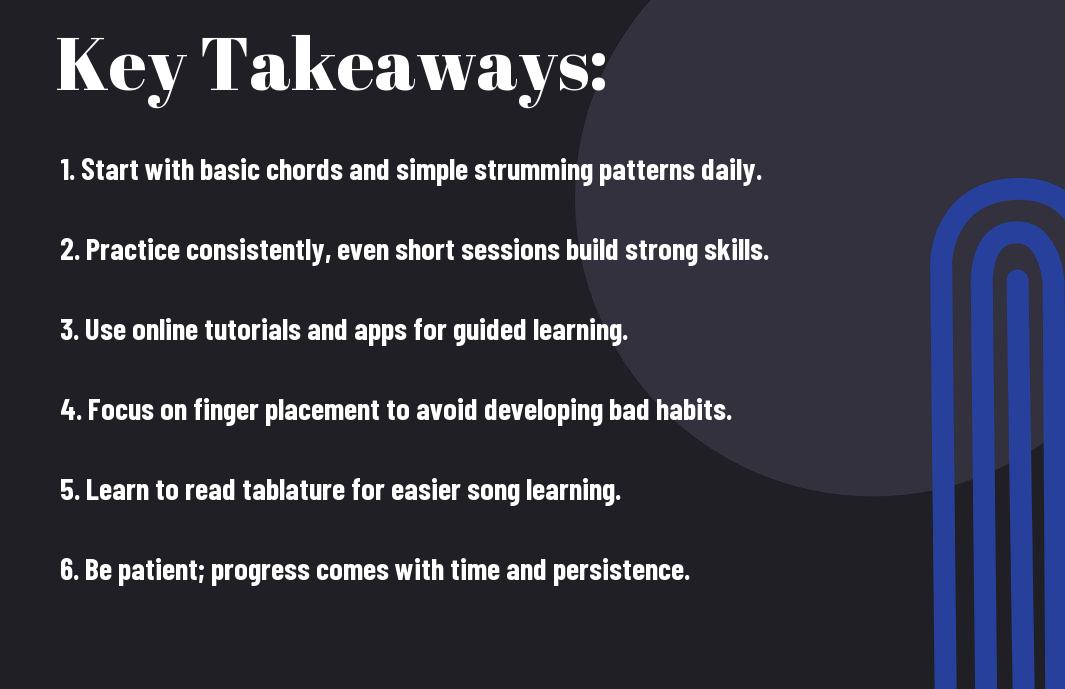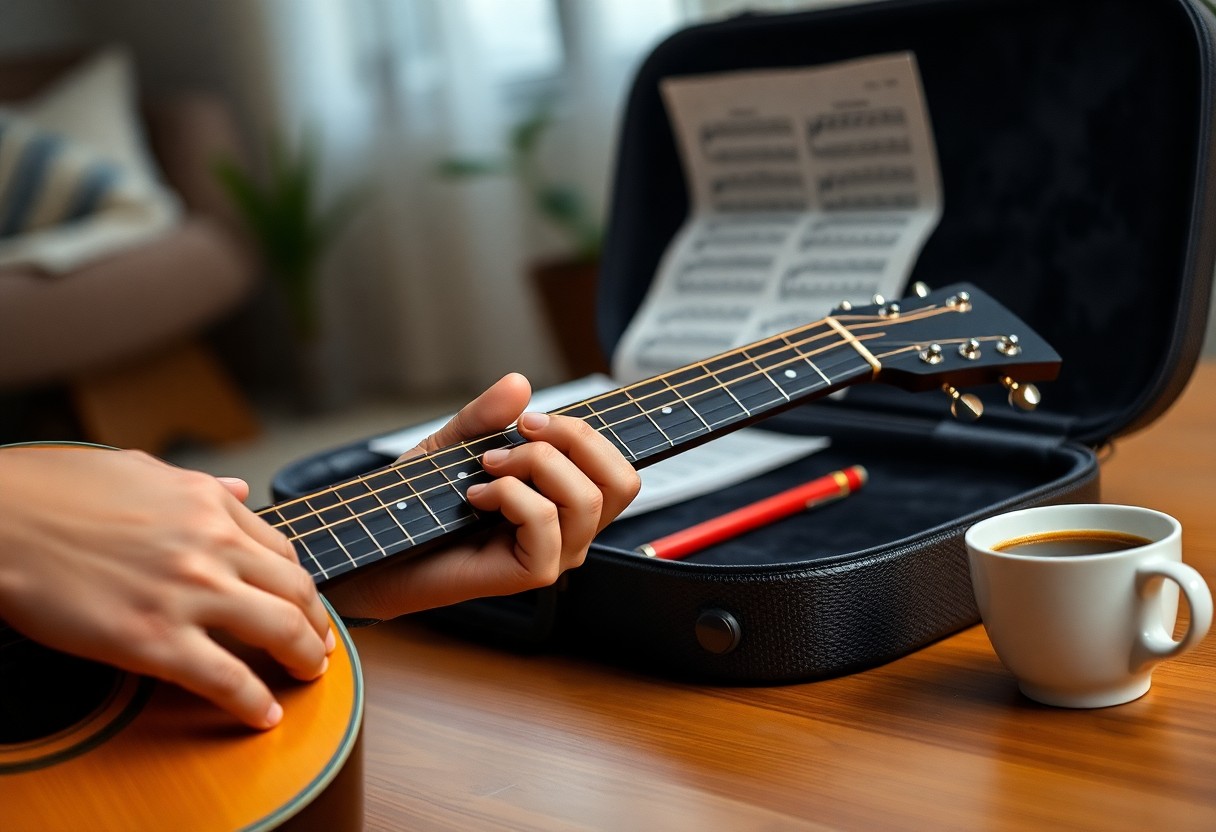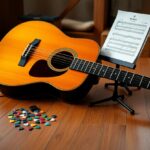There’s a sense of accomplishment that comes with learning guitar from scratch, and I want to share my journey with you. Starting this musical adventure can feel overwhelming, but with practice and the right guidance, you can develop your skills in playing this versatile instrument. I’ll guide you through the important steps, from choosing the right guitar to mastering basic chords and techniques. You’ll find that patience and dedication are your best friends in this process, opening doors to a world of creativity and expression.

Crafting Your Personal Guitar Journey
Embarking on a guitar learning adventure is a deeply personal experience, shaped by your interests and aspirations. I’ve found that defining your unique journey helps keep motivation alive. Consider the styles of music you love, the skills you wish to master, and your individual pace of learning. By tailoring your approach, you not only enhance your enjoyment but also increase your chances of sticking with this rewarding pursuit in the long run.
Choosing the Right Guitar for Your Needs
Selecting a guitar that suits your style and needs is a fundamental step. I recommend starting with either an acoustic or electric guitar based on your musical preferences. An acoustic guitar is great for strumming along to folk tunes, while an electric guitar can bring versatility and an array of sounds to rock or jazz. Set a budget and play a few models before committing—finding one that feels comfortable in your hands makes a world of difference.
Establishing Realistic Goals and a Practice Schedule
Setting achievable goals and forming a practice schedule allows for steady progress. I start by breaking down larger objectives, like learning to play a full song, into smaller, manageable tasks. Aim for a minimum of 20-30 minutes of practice daily, focusing on specific skills or techniques. Your schedule should accommodate your lifestyle but remain consistent enough to foster growth; even a few short sessions each week can yield significant results over time.
Creating a sustainable practice schedule helps cultivate discipline and makes learning enjoyable. I set short-term goals like mastering a chord or a specific strumming pattern within a week. This approach keeps things interesting and less overwhelming. Tracking your progress through a journal can boost motivation, allowing you to celebrate small victories along the way. Finding a balance between dedication and flexibility ensures that guitar playing becomes a fulfilling part of your routine rather than a chore.
Essential Techniques Every Beginner Must Master
Building a solid foundation is necessary for any aspiring guitarist. I believe that grasping a few key techniques will not only enhance your playing but also make the learning curve more enjoyable. Focusing on understanding string anatomy, mastering basic chords, and developing simple strumming patterns are all pivotal techniques to cultivate as you launch on this musical journey.
Understanding String and Fret Anatomy
Guitar anatomy forms the backbone of your playing. Each string, numbered from the thinnest to the thickest, corresponds to a particular note: E, A, D, G, B, and E. The frets represent different pitches, with each fret raising the pitch of the string by a half step. As you play, practice positioning your fingers just behind a fret to produce clean sound, and positioning your finger tips to avoid buzzing. This understanding will empower you to navigate the guitar fretboard with confidence.
Basic Chords and Their Significance
Life as a guitarist really begins with chords. Chords are the building blocks of many songs, and as a beginner, you’ll want to familiarize yourself with basic open chords, such as C, G, D, E, and A. These chords are fundamental because they appear in countless popular songs. Mastering these shapes will give you the confidence to play along with your favorite tracks and form a solid base for more complex progressions later on.
The significance of basic chords cannot be overstated. They unlock a vast repertoire of music; almost every song is constructed around a handful of chords. For instance, the popular “C-G-Am-F” progression appears in songs from various genres. Learning to transition smoothly between each chord not only helps in developing your finger dexterity but also prepares you for future exploration into more advanced chord structures and progressions. Don’t hesitate to practice these chords frequently; they will serve as your gateway to playing full songs, gaining confidence with every strum.
Simple Strumming Patterns That Work
Strumming patterns are another key element in creating rhythm in your playing. I recommend starting with simple downstrokes and alternating between down and up strums. Patterns like “D-DU-UDU” (where D stands for downstrum and U for upstrum) can really enhance your playing style. These basic patterns will not only help keep your rhythm but also allow you to intuitively follow more complex songs as you advance.
Experimenting with basic strumming patterns is a great way to add flair to your chords. For example, using a “down-down-up-up-down-up” pattern can instantly spice up your playing, and it’s used in many popular songs. Developing a groove with these patterns helps internalize rhythm, which is fundamental for any musician. Regular practice will increase your timing and give your music more breath and energy. Don’t be afraid to tweak these patterns; personalizing them can help you find your unique sound as a guitarist.
Unlocking the Power of Music Theory
Understanding music theory opens up a whole new dimension for guitarists. It serves as a foundational tool that helps me make sense of the vast world of music. By grasping the principles of music theory, I can explore ideas around melody, harmony, and rhythm more deeply, elevating my playing from just strumming chords to creating unique and expressive pieces.
Decoding the Language of Music: Notes and Scales
Notes and scales form the bedrock of music. Each note has a specific frequency, and when arranged in a scale, they create a sonic ladder that can evoke a range of emotions. For instance, the major scale often conveys a happy or uplifting feeling, while the minor scale leans towards a more somber tone. Learning these scales allows you to improvise and create melodies that resonate with your listeners.
How Chord Progressions Shape Songwriting
Chord progressions are the backbone of nearly every song you’ll encounter. They provide the harmonic structure that defines the emotion of the piece and guide the listener through its journey. Often, a simple progression like G-C-D can evoke a sense of nostalgia, while more complex sequences, like ii-V-I, can create tension and resolution. This structure is not just about what sounds good; it directly influences how I compose and arrange my music.
Analyzing classic songs reveals how tied to emotion and meaning chord progressions can be. For example, the iconic progression I-V-vi-IV can be found in countless hits, such as “Let It Be” by The Beatles and “With or Without You” by U2. This consistency across various genres showcases why learning to recognize and create effective chord progressions is vital for your songwriting toolkit. By mastering these combinations, you’ll gain the ability to evoke specific feelings and tell stories through your music. As I experiment with different progressions, I discover how they can shift the mood, which informs my overall songwriting process.
Building Confidence Through Regular Performance
Performing regularly, whether in front of friends or at local events, fosters a sense of achievement that enhances your journey as a guitarist. Each performance builds your confidence and improves your skills. With every opportunity to showcase your talent, you find comfort in expressing yourself through music, while reinforcing your commitment to practice and progress. This cycle of practice and performance accelerates your growth and motivates you to push past limits. Thou can only improve by stepping out of your comfort zone.
The Importance of Playing with Others
Sharing music with fellow musicians significantly boosts your development and confidence. Playing with others encourages collaboration while exposing you to diverse styles and techniques that can inspire your playing. It cultivates a sense of community, and the support from fellow musicians can ease nerves. This shared experience transforms performance into a joyful exchange rather than a stressful endeavor. Thou truly grow together through shared musical moments.
Tips for Overcoming Performance Anxiety
Many musicians face performance anxiety; it’s a common obstacle that can be managed. Begin by practicing mindfulness and breathing techniques to ground yourself before taking the stage. Familiarizing yourself with the venue and doing a sound check can also provide comfort. Set achievable goals for each performance, such as focusing on the enjoyment of playing rather than striving for perfection. There’s no denying that preparation and positive self-talk can help quell those nerves. Thou shall keep these techniques in your back pocket for strength.
- Practice mindfulness to stay grounded.
- Familiarize yourself with the venue beforehand.
- Focus on enjoyment over perfection.
- Set achievable goals for your performance.
- Utilize positive self-talk to combat anxiety.
Delving deeper into overcoming performance anxiety, I find that visualizing a successful performance can be a game-changer. Picture yourself on stage, playing confidently and receiving applause. Establishing a routine that includes warm-ups and familiar pieces can also enhance your comfort. Engaging in regular performances, big or small, allows you to understand that nerves are natural and can serve as an adrenaline boost rather than a barrier. Thou must embrace this journey of growth to become the guitarist you aspire to be.
- Visualize a successful performance.
- Establish a warm-up routine before playing.
- Engage in regular performances to gain experience.
- Focus on the excitement rather than fear.
- Embrace the journey of growth as a musician.
Resources for Continuous Improvement
Continuous improvement is crucial to mastering the guitar. I have found that leveraging technology and discovering local communities can significantly enhance my skills. Engaging with various resources not only keeps you motivated but also provides diverse perspectives and methods of learning. For a comprehensive starting point, I highly recommend checking out the [NEWBIE] Guide to learning guitar from scratch? that offers a wealth of information for beginners.
Best Online Platforms and Apps for Learning
Numerous online platforms and apps can guide your learning journey. Sites like GuitarTricks and Fender Play provide structured lessons tailored to your skill level. Additionally, mobile apps such as Yousician and Ultimate Guitar make practice engaging with interactive features. I find these resources keep my practice sessions fresh and exciting while adapting to my progress.
Finding Local Communities and Instructors
Connecting with local communities or instructors can significantly influence your learning experience. Joining a local music group or attending workshops allows you to share experiences and techniques that could transform your playing. I discovered Meetup and local Facebook groups where passionate guitarists gather, exchanging advice and learning from each other. Having guidance from skilled instructors can clarify tricky concepts and provide personalized feedback, which is invaluable for growth.
Local music communities often host events and jam sessions that provide live performance experience and a chance to network with other musicians. These gatherings not only foster collaboration but also ignite a sense of belonging among fellow guitarists. Many instructors offer group lessons at affordable rates, making quality education accessible while you hone your skills alongside peers. By stepping into these settings, I’ve gained confidence, motivation, and a deeper understanding of my musical journey.
Final Words
Presently, as I reflect on my journey of learning guitar from scratch, I realize that patience and consistent practice are the keys to progress. Each chord mastered and song played brings a sense of accomplishment that fuels my passion. I encourage you to embrace the challenges and celebrate small victories along the way. With dedication and the right resources, you can transform your musical aspirations into reality. Trust the process, and soon you will be strumming along to your favorite tunes with confidence.




